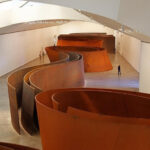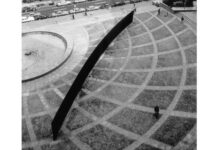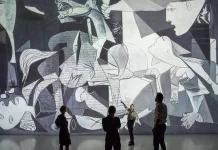The text discusses the significance of space in the work of the American artist Richard Serra. It starts by emphasizing the importance of space in our lives, not just as a utilitarian resource but also as a metaphysical concept. Serra’s diverse artistic career, which includes painting, drawing, video, performance, writing, and dance, is briefly mentioned, but the focus is on his sculptural oeuvre.
Serra’s early works, known as “Gutter Splashes,” are described as part of the Process Art movement, emphasizing the physical action and medium’s role within a specific environment. These early experiences influenced Serra’s interest in the relationship between aesthetic objects and space, leading to his creation of “Props,” which challenged balance and physicality.
The text highlights the brute, intuitive nature of Serra’s sculptures, which are heavy and potentially dangerous, yet possess a delicate grace. It draws a parallel between Serra’s art and a steel ship’s weight and movement in water, emphasizing the transformative power of sculpture.
Serra’s transition to site-specific art, inspired by his friend Robert Smithson, is discussed, emphasizing how specific locations can inspire and contextualize art. The controversial installation of “Tilted Arc” in Lower Manhattan is explored, illustrating Serra’s ability to redefine spaces with his art.
The text also underscores the importance of scale in Serra’s work, as his large steel sculptures require viewers to physically engage with and navigate through space, leading to a deeper understanding of space’s essential characteristics.
In summary, the text provides insights into Richard Serra’s artistic journey, his exploration of space, and his role in challenging conventional perceptions of art and space, ultimately inviting viewers to contemplate space on a non-utilitarian level.

Richard Serra
Richard Serra, born on November 2, 1938, in San Francisco, California, is a prominent American sculptor known for his monumental and innovative works in the field of contemporary art. Throughout his career, Serra has pushed the boundaries of sculpture, challenging conventional notions of space, materiality, and perception.
Key aspects of Richard Serra’s life and work include:
- Early Life and Education: Serra studied art at the University of California, Santa Barbara, and later at Yale University, where he was mentored by renowned artists such as Josef Albers and Philip Guston. These formative years laid the foundation for his future artistic exploration.
- Minimalism and Process Art: In the 1960s, Serra was associated with the Minimalist and Process Art movements. His early works featured simple geometric shapes and industrial materials, reflecting his interest in the physical properties of materials and their interaction with space.
- Monumental Sculptures: Serra is perhaps best known for his massive, site-specific sculptures made from steel. These sculptures often consist of towering, curved steel plates that create immersive and labyrinthine experiences for viewers. “Tilted Arc” (1981) is one of his most famous works, which generated controversy when it was installed in Federal Plaza, New York City, leading to its eventual removal.
- Site-Specific Art: Serra’s works are often designed to interact with specific architectural or natural environments. He is a pioneer in the field of site-specific art, and his sculptures are carefully integrated into their surroundings, altering the way people perceive and move through space.
- Material Exploration: Serra’s choice of materials, particularly weathered steel, plays a crucial role in his work. The rusted surfaces of his sculptures create a tactile and visual contrast with their surroundings, evoking a sense of time, history, and impermanence.
- Process and Gesture: Serra’s creative process is highly physical and gestural. He often uses his body to shape and manipulate materials, and the marks of his labor are left visible on the finished pieces. This emphasis on process and presence is a defining characteristic of his work.
- Legacy: Richard Serra’s work has had a profound impact on contemporary sculpture and the broader art world. His sculptures challenge viewers to engage with space and material in new and immersive ways. His contributions to the art world have earned him numerous awards and honors, including the Golden Lion for Sculpture at the Venice Biennale in 2001.
Richard Serra’s art continues to inspire and provoke dialogue about the nature of sculpture, architecture, and the relationship between art and its environment. His dedication to pushing the boundaries of artistic expression has left an enduring mark on the world of contemporary art, making him a celebrated and influential figure in the field.
School of the Art, Tira
Art Education



















